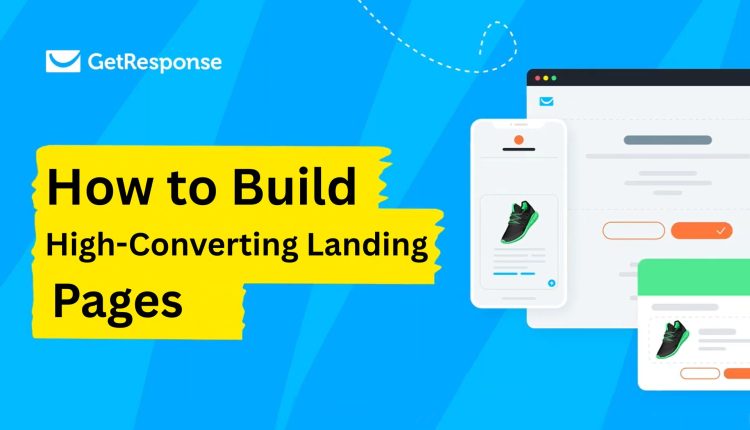
How To Build High-Converting Landing Pages With GetResponse
1. Introduction
A landing page is a specific web page designed to convert visitors into leads or customers. It has an important role in digital marketing by focusing on a single goal. GetResponse is an effective platform that makes creating landing pages easier. Its user-friendly drag-and-drop builder, users can create professional designs without coding.
Businesses can optimize their pages for conversions with built-in features. The platform also provides automation features that improve lead generation. Understanding how to use GetResponse effectively can improve engagement and increase sales.
2. Understanding High-Converting Landing Pages
A high-converting landing page grabs attention and encourages engagement. It starts with an engaging headline that quickly conveys value. A clear and effective call to action (CTA) guides visitors to the next step. Visual elements like images and videos improve engagement and build trust.
Testimonials and social proof increase credibility and reduce hesitation. Reducing interruptions keeps users engaged with the offer. Mobile optimization ensures accessibility on all devices. These elements work together to increase conversions and improve marketing performance.
3. Getting Started with GetResponse Landing Pages
GetResponse offers an easy way to create landing pages without technical skills. Users start by selecting a template that suits their campaign. The platform provides a variety of customizable designs for different industries.
The drag-and-drop editor enables easy adjustments to text, images, and layouts. Custom domains can be used to maintain brand consistency. Built-in integrations with email marketing and automation platforms improve functionality.
Publishing the page is easy and requires just a few clicks. This makes GetResponse a great choice for businesses looking to grow online.
4. Designing an Effective Landing Page
An effective landing page blends visual appeal with practical features. The design should be simple and user-friendly. Using contrasting colors for CTA buttons helps them grab attention. Short and engaging copy conveys a clear message without confusing visitors. Bullet points simplify information, making it more readable and accessible.
Trust signals, including badges and security icons, help build user confidence. Adding a limited-time offer creates urgency and motivates quick action. Each design choice should help guide the visitor in making a decision.
5. Optimizing for Conversions
Landing page optimization is essential to increase its effectiveness and efficiency. A/B testing enables marketers to evaluate different versions and improve performance. Headlines and CTA buttons should be tested to ensure they are effective.
Lead capture forms should be simple and collect only the most important information. Using a countdown timer can increase urgency and lead to more sign-ups.
Personalization, such as including the visitor’s name, can improve engagement. Integrating chatbots can provide real-time assistance and increase conversions. Regular analysis and improvement lead to higher success rates.
6. Mobile-Friendly & Page Speed Optimization
A mobile-friendly landing page provides a smooth experience for all users. The design should automatically adjust to different screen sizes. Large, tappable buttons make it easy to navigate on touch devices. Quick loading speed keeps visitors from leaving while the page loads.
Compressing images and reducing unnecessary scripts can improve performance. Avoiding excessive pop-ups ensures a smooth browsing experience. Google gives higher search rankings to mobile-optimized pages. A well-optimized page improves engagement and keeps visitors focused on the product.
7. SEO Best Practices for Landing Pages
SEO helps landing pages attract organic traffic from search engines. Optimizing the page title and meta description improves visibility. Using relevant keywords naturally within the content enhances search ranking.
A clear URL structure makes it easier for both users and search engines to understand the page. Internal linking connects the landing page to related content, improving navigation.
Fast loading speed and mobile optimization contribute to better rankings. Including alt text for images helps search engines index the content. A well-optimized landing page increases both traffic and conversions.
8. Tracking & Analyzing Performance
Tracking landing page performance helps marketers make decisions based on data. GetResponse provides analytics tools to monitor visitor behaviour. Heatmaps show which sections of the page attract the most attention. Conversion tracking shows which elements lead to sign-ups and sales.
A/B testing data helps improve the design and messaging. Google Analytics can be integrated for more detailed insights. Regularly checking data helps marketers improve their campaigns. Adjustments based on performance metrics lead to continuous growth and success.
Conclusion
Creating a high-converting landing page with GetResponse is easy and effective. Understanding the essential elements of a landing page improves design choices. GetResponse tools provide easy customization and optimization. Mobile-friendly design and quick loading speed improve the user experience.
SEO best practices help attract more organic traffic. Tracking performance provides valuable insights for continuous improvement. Using these strategies helps businesses to generate more leads and increase sales with optimized landing pages.